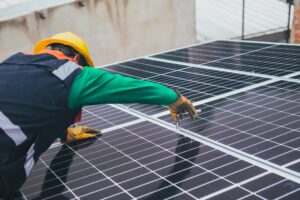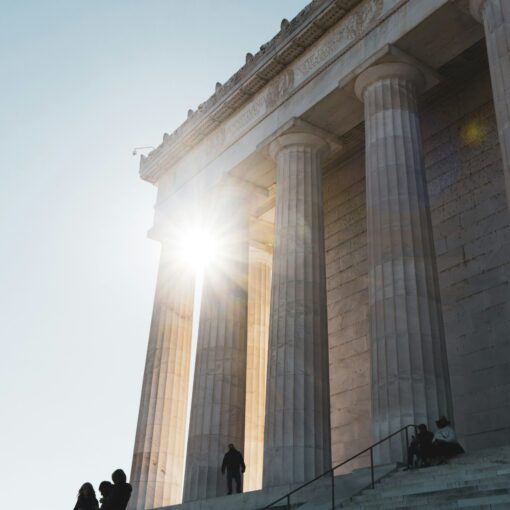 This week, the U.S. Environmental Protection Agency (EPA) released preliminary program design details for the Greenhouse Gas Reduction Fund (GGRF) established by Section 60103 of the 2022 Inflation Reduction Act (IRA). Specifically, the EPA published two “assistance listings” designed to help potential applicants identify funding opportunities. The publication stops short of answering the many questions raised in EPA’s October 2022 request for information seeking stakeholder input, and is not a formal notice of funding opportunity or call for funding applications. However, it does provide insight into EPA’s plans for the GGRF, including the $20 billion appropriation for so-called “green banks” (though the IRA does not use this term).
This week, the U.S. Environmental Protection Agency (EPA) released preliminary program design details for the Greenhouse Gas Reduction Fund (GGRF) established by Section 60103 of the 2022 Inflation Reduction Act (IRA). Specifically, the EPA published two “assistance listings” designed to help potential applicants identify funding opportunities. The publication stops short of answering the many questions raised in EPA’s October 2022 request for information seeking stakeholder input, and is not a formal notice of funding opportunity or call for funding applications. However, it does provide insight into EPA’s plans for the GGRF, including the $20 billion appropriation for so-called “green banks” (though the IRA does not use this term).
The GGRF provisions of the IRA appropriate three pots of funding, which EPA’s announcement affirms will be allocated through two separate competitive grant programs. The IRA’s $7 billion appropriation for “grants, loans, or other forms of financial assistance, as well as technical assistance, to enable low-income and disadvantaged communities to deploy or benefit from zero-emission technologies, including distributed technologies on residential rooftops, and to carry out other greenhouse gas emission reduction activities” is to be allocated through the Zero Emission Technologies Grant Program. A second competitive grant program, the General Assistance & Low-Income & Disadvantaged Communities Grant Program, will administer $20 billion appropriated for projects that “reduce[] or avoid[] greenhouse gas emissions and other forms of air pollution in partnership with, and by leveraging investment from, the private sector; or assist[] communities in the efforts of those communities to reduce or avoid greenhouse gas emissions and other forms of air pollution” (i.e., “green banks”). (The IRA broke this $20 billion program into two appropriations: $8 billion for the listed activities in “disadvantaged communities,” and another $12 billion for the same activities in any area.)
While local governments are directly eligible to apply for funding only from the Zero Emission Technologies Grant Program, both programs will have implications for municipal governments and communities nationwide. In addition, the new details about the General Assistance & Low-Income & Disadvantaged Communities Grant Program respond to persistent questions about how the green bank program will be designed.
General Assistance & Low-Income & Disadvantaged Communities Grant Program
Of the two programs established via the GGRF, the General Assistance & Low-Income & Disadvantaged Communities Grant Program (established in IRA sections 60102(a)(2) & (3)) is the one that raises far more questions about implementation. The program will fund some number of “green banks” — entities that leverage public funding to attract private funding and advance green energy or energy efficiency projects. While there are a handful of green banks operating in the U.S., the $20 billion scale of the GGRF program dwarfs the capital currently available from green banking institutions. Moreover, the IRA’s green banks have been the subject of significant speculation and advocacy. Will the GGRF fund one, several, or many green banks? Will funding go to established green banks, governmental entities, newly-created nonprofit organizations, or existing community development financial institutions (CDFIs)? What kinds of projects will be funded and what oversight will be required? EPA’s announcement responds to some but not all of these questions.
In its assistance listing, EPA stated that it anticipates making “between 2 and 15 grants” to green bank institutions (though it still does not use the term “green bank”), indicating that there will not be one single nationwide green bank, nor dozens of them, nor even one per state. Still, EPA notes that it “is developing this program and will determine the range and average of financial assistance” at a later time. Separately, EPA has not foreclosed the possibility of a “national” green bank, even though it anticipates more than one grantee. A range of scenarios are therefore possible: a large “national” green bank with one or more additional institutions also offering green bank-type financing on a smaller scale; several regional green banks; grants to existing institutions such as CDFIs to expand into the green financing space; or some combination of approaches. EPA anticipates issuing a Notice of Funding Opportunities (NOFO) with additional details in summer 2023.
Governmental entities are not eligible to apply for green bank funding directly, though this announcement does not expressly prevent them from playing a role in “eligible recipient” organizations. For example, a local government could (pending any additional limitations in the summer 2023 NOFO) consider partnering or negotiating with an organization that is eligible to act as a green bank to ensure local financing needs are met. An “eligible recipient” is defined in the IRA as “a nonprofit organization that (A) is designed to provide capital, leverage private capital and provide other forms of financial assistance for the rapid deployment of low- and zero-emission products, technologies, and services; (B) does not take deposits other than deposits from repayments and other revenue received from financial assistance using the grant funds; (C) is funded by public or charitable contributions; and (D) invests in or finances projects alone or in conjunction with other investors.” However, EPA expressly notes that it may further “limit which eligible recipients may apply” in its future NOFO.
Zero Emission Technologies Grant Program
The Zero Emission Technologies Grant Program will implement IRA Section 60103(a)(1) (codified as Clean Air Act Section 134(a)(1)). Of the two programs, this one is simpler to implement. Municipalities are eligible to apply for funding, as are states, Tribal governments, and nonprofit green bank institutions. Per the EPA’s announcement, grant amounts must “provide financial and technical assistance to enable low-income and disadvantaged communities to deploy or benefit from zero-emission technologies.” Further, the funding is to “prioritize delivering financial and technical assistance to projects that deploy residential and community solar, associated storage technologies, and related upgrades” and “support the creation of high-paying jobs.” Among the other new details, EPA shared that it “expects to award up to 60 grants” through the Zero Emission Technologies Grant Program, though this is not a firm commitment. A total of $7 billion spread across 60 grants suggests that grant awards will be on the order of $100+ million, though it’s likely some grant amounts will be higher and others lower. The IRA requires funding to be obligated by September 2024, and while EPA says that funding applications will be requested as early as summer 2023, the announcement appears to suggest grants will not be made in fiscal year 2023.
All in all, EPA’s announcement about the Zero Emission Technologies Grant Program offers little additional information to local governments and others considering applying for funding. It affirms EPA’s commitment to funding projects in disadvantaged communities and leaves additional details to a forthcoming NOFO. It does, however, give a sense of the number and likely average size of grants made through the program.
Justice40 and Disadvantaged Communities
As with other aspects of the IRA, both the General Assistance & Low-Income & Disadvantaged Communities Grant Program and the Zero Emission Technologies Grant Program are to be administered consistent with the Biden Administration’s Justice40 commitment to making “certain Federal investments [such] that 40 percent of the overall benefits flow to disadvantaged communities.” The assistance listing for the General Assistance & Low-Income & Disadvantaged Communities Grant Program further notes that the program has ”a particular emphasis on projects in low-income and disadvantaged communities.” However, given that the General Assistance & Low-Income & Disadvantaged Communities Grant Program allots 40 percent of its funding for use in disadvantaged communities, and that the Zero Emission Technologies Grant Program already directs grant amounts to low-income and disadvantaged communities, the assistance listings do not add to the existing understanding of these programs’ focus on disadvantaged communities.
Additional Procedural Details
The assistance listings for both programs, while scant on details, provide some insight into the application process. For both programs, preapplication coordination with EPA is required, meaning that potential applications should reach out to EPA to discuss their proposals before submitting a formal application. The programs are also subject to EPA’s implementation procedures for the National Environmental Policy Act (including environmental review requirements), though it is not clear what this means for any single application or grant. The programs are both eligible for intergovernmental review under Executive Order 12372 of 1982. In states where intergovernmental review is in effect, EPA recommends applicants reach out to the appropriate office in the state for further direction. In addition, both programs are subject to EPA reporting requirements, including a yearly audit required of any nonfederal entity that spends more than $750,000 in one year. However, no information is given about additional reporting, audit, or oversight requirements that could be required of green banking entities.
Takeaways for Local Governments
The assistance listings leave more questions unanswered than not. The NOFOs anticipated later in 2023 will need to include significantly more detail about each program’s eligible recipients and projects. It’s possible that a full picture of the green banking landscape will not emerge until grants are actually made from the General Assistance & Low-Income & Disadvantaged Communities Grant Program.
Still, there are several broad takeaways. First is EPA’s continued commitment to directing GGRF funds to disadvantaged communities, as required by both the IRA itself and the Justice40 commitment. Second, a significant amount of coordination will be required — with the EPA, with state and local agencies empowered to participate in intergovernmental review and, though this is not explicit in the assistance listings, among stakeholders and potential partners. The commitment to expend funds in disadvantaged communities means that successful applicants will need to convince EPA that grants will in fact benefit such communities, a proposition that requires outreach and coalition building. For local governments considering applying for a Zero Emission Technologies grant, outreach, coalition building, and a commitment to disadvantaged communities should remain central to planning efforts. Finally, while it is not clear what form the GGRF’s green banks will take, EPA indicates that there will likely be several of them, meaning that there is room for local governments to explore partnerships with potential green bank entities, shaping these entities and possibly strengthening the likelihood of their applications’ success.
Amy Turner is the Director of the Cities Climate Law Initiative at the Sabin Center for Climate Change Law at Columbia Law School.




